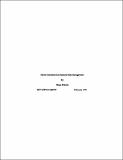Micro economics for demand-side management
Author(s)
Kibune, Hisao
Download28596149.pdf (1.129Mb)
Metadata
Show full item recordAbstract
This paper aims to interpret Demand-Side Management (DSM) activity and to point out its problems, adopting microeconomics as an analytical tool. Two major findings follow. first, the cost-benefit analysis currently in use has the following problems: (i) inconsistency in cost comparison between utility costs on the supply-side and utility costs plus customer costs on the demand-side, (ii) inconsistency in price comparisons among different consumption levels, and (iii) arbitrary pricing after DSM implementation. Second, DSM programs can be recognized as a conventional economic activity, if we assume "energy service concept" as a definition for demand and also recognize the DSM program as a supply-side option. Concurrently, (i) DSM is justified, since it increases social welfare, and (ii) we are in a position to determine the amount of rebate to be paid. However, (iii) the utility bill of a DSM participant should not be reduced in the name of demand reduction, since the utility continues to provide energy service at the same volume, and must recover the DSM costs in order to avoid double payment to the participant. (iv) We note that the compensation method of DSM cost recover, which is applied in several states, has a limitation. (v) The interpretation of DSM activity proposed in this paper is also useful in the case of marginal cost supply-side decrease.
Date issued
1991Publisher
MIT Center for Energy and Environmental Policy Research
Other identifiers
91-004
Series/Report no.
Working paper (Massachusetts Institute of Technology. Center for Energy Policy Research) ; MIT-CEPR 91-004.